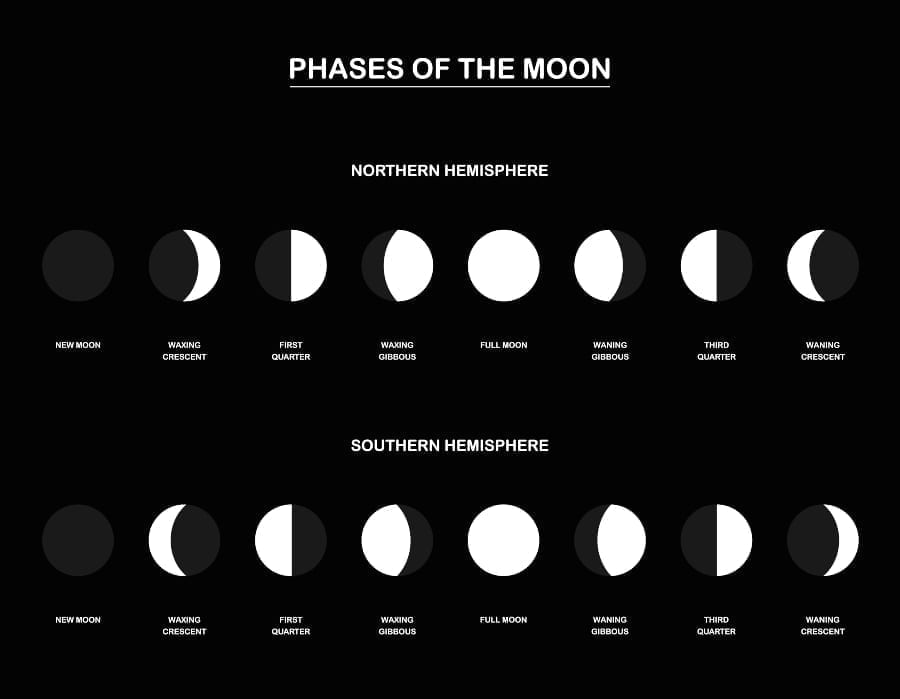What ARE Moon Phases, and Just HOW MANY are There?
The Moon phases are the different stages that the Moon goes through as she moves around the Earth each lunar month.
According to different cultures, you may hear of three, four, or even eight Moon phases in a single lunar cycle.
The Moon has been our constant companion since time on Earth began, so is it any wonder that the way we describe her changes a little across the world? Yet, here in the West, there are most commonly understood to be four distinct phases, also known as lunar phases. Plus, in addition to these four phases of the Moon, are four more intermediary phases – making eight in total.
These are:
- New Moon
- Waxing Crescent
- First Quarter
- Waxing Gibbous
- Full Moon
- Waning Gibbous
- Third/ Last Quarter
- Waning Crescent
Shhhh… Don’t Tell Anyone but the Moon is Actually Always FULL!
Yes, it’s true. One side of the Moon is always fully illuminated! But, because of the way the Earth orbits around the Sun, and the Moon orbits around the Earth, how much we actually get to see of this Full Moon changes.
It’s this changing viewpoint that creates the phases of the Moon.
Here’s a quick rundown of each phase, how much of the Moon is illuminated in each, and the kind of energy it carries:
**Note, that in the Northern and Southern hemispheres, the side of the Moon that is illuminated is reversed. So in the Northern hemisphere, the waxing Moon lights up from the right-hand side. And in the Southern hemisphere, She waxes from the left.
New Moon
The Moon is invisible.
Because she rises with the Sun, the Moon is ‘bleached out’ by sunlight during the day, and dips below the horizon at night. This means that often if the sky is cloudless at the New Moon phase, the stars show up really brightly.
As the start of the lunar cycle, this phase is dark and fertile. It’s also a sensitive time, people can feel like they want to be alone, energy is low and socializing tends to take a dip.
Waxing Crescent
The Moon is illuminated 1 – 49%
The energy the crescent Moon emits at this phase is emergent. Generally, energy begins to rise a little and the outlook s more positive and creative.
First Quarter
The Moon is illuminated 50%
In astrology, this aspect is called a square, when Sun and Moon sit at right angles to each other. Its energy can feel like friction, like a block that needs to be pushed through to find progress.
Waxing Gibbous
The Moon is illuminated 51 – 99%
The waning gibbous Moon phase is lively, connected and has a pregnant fullness that has almost reached completion… but not quite. Often it requires stamina and persistence to meet goals, or course correction at this time.
Full Moon
100% illumination
This is the peak of the Moon cycle. 180º apart, the Moon opposes the Sun, catching his light fully across her visible face.
The energy of the Full Moon phase is celebratory and climactic.
Waning Gibbous
The Moon is illuminated 99 – 51%
This phase of the cycle has a softness. It’s time to harvest whatever has grown and ripened so far. Often people find that a keen eye for detail seems to occur at this lunar phase.
Third/ Last Quarter
The Moon is illuminated 50%
The opposite half of the Moon is visible, to the first quarter Moon (these are different in the northern and southern hemispheres).
Again, some friction may be felt or a critical choice may appear. Often as the light retreats, this will require inner work.
Waning Crescent
The Moon illuminated 49 – 1%
A crescent Moon appears once more, again, the opposite side is lit to the waxing crescent. This is a time of growing darkness, emotional sensitivity, and rising intuition.
Space and retreat are recommended.

